Driven by the resurgence in kingfish numbers, offshore jigging has been in the spotlight over the past few years and more people are keen to get into this unique branch of our sport.
While it may not be as simple or easy as some other styles of angling, like spinning from the rocks or casting a few lures around the estuary in search of bream or flathead, jigging can be reasonably straightforward – and good exercise.
Even those without a boat can book a day on one of the many specialist charter services along the coast and when the costs add up, the charter option makes a lot of sense. It may seem a touch expensive at first, but when you consider costs such as fuel, boat and motor maintenance and other expenses associated with running a decent size offshore vessel, simply jumping on a charter boat with a few mates works out quite well.
Whichever option you choose, the other main consideration is setting up the tackle.
Quite a variety of different rods, reels, line and jigs can be used.
The exact species of fish and depth of water you’re to be fishing in are other things to think about, but for the most part, jigging along the NSW coast is all about kingfish and the water is reasonably deep. We’re probably looking at depths of 60m to 120m on most jigging grounds.
If you’re not 100% sure if this sort of fishing is right for you than the best idea is to book a day on a charter boat or head out with a mate and try it for yourself.
If possible, try to borrow a jigging outfit or at least use gear that is capable of holding a lot of line and that won’t pack it in after just one or two fish.
If all goes well and you hook into some hard fighting kings, you’ll be looking to buy your own gear. This can be the tricky bit, because good jigging tackle isn’t exactly cheap.
A common mistake many people make when choosing their first jigging rod is to go for something that’s more of an iron bar, rather than a nice light rod.
It’s easy to think big jigs, big fish, so go for the strongest rod you can find. That’s partly OK, rods do need to be strong, but a strong rod doesn’t need to be overly stiff or heavy in the hand.
There are a few aspects to look at before making the purchase.
Don’t worry too much about the brand names because a lot of really good jigging rods aren’t common or familiar names.
Yes, the big-name manufacturers have good jigging rods in their ranges but there are a number of quality rods of Japanese origin out there with strange sounding names, like Hots Fake Lez or Maria Steady.
More importantly, take a look at the components on the rod. Fuji and ALPS are the names to look for on the reel seats and if you can’t see a name on the seat, ask the sales person about it. If it’s a cheaper reel seat it may end up cracking or becoming loose, causing the reel to fall off.
The guides on a decent rod should bear the Fuji name.
Jigging rods are generally rated for the size of the jigs being used and the braid, or PE, line.
A rod rated for 250g to 400g and PE 5 or 6 is pretty heavy duty and will be more like a broomstick to use.
A more user-friendly rod would be rated at something like 150g to 250g and PE 3 or 4. This means that it will flex more while jigging and when fighting a fish, thus putting much less strain on the angler.
Shorter rods are also much better to use than longer rods. In most cases a rod between 5’3” and 5’9” will be about right.
This is about the most daunting part of the tackle kit – a good jigging reel isn’t cheap.
Time after time I’ve seen supposedly robust reels fail when put through their paces. What generally happens is that the newcomer is hesitant about forking out big bucks and goes for something more budget-priced.
Initially, a reel of around $300 may seem fine but after a few trips some problems can start to occur. Handles become wobbly and gears feel a bit grindy.
A month or two down the track, the budget reel may need a few parts replaced. I’ve seen bail arms snap off, handles break and reels completely seize up after only a few months of use.
If possible, save up or lay-by if you have to, but try to buy the best you can afford. That generally means spending a minimum of $600 for a threadline or $350 for an overhead.
Once you’ve got the right reel, look after it by rinsing the salt off after each trip to sea and giving it a few drops of oil here and there.
When not using it, back off the drag pressure as well. A slower gear ratio will make things easier for you than faster gearing, so go for a ratio of around 4:1 rather than 6:1.
Like other components in the jigging system, quality line will do you a lot more favours than cheaper alternatives. I use premium quality Sunline PE, which is extremely thin for its breaking strain and remains supple after quite a long time.
The finer the line diameter, the less water resistance, which means jigs will fall faster so you get down to the fish quickly.
In most cases PE 3 to PE 5 (35lb to 60lb or 16kg to 27kg) will be about right.
I mainly use a PE 3 Sunline rated at 50lb. With 50m or so of heavy mono backing on my 4500-size threadline reels, I can get 300m of this PE 3 on the spools.
Leaders aren’t quite as important as the main lines, but a tough 24kg to 40kg nylon mono is about right for most situations.
In the lighter classes, go for a fluorocarbon because it will be more abrasion resistant, but fluorocarbons over 30kg tend to be very stiff so I prefer mono most of the time.
These days the variety of deepwater jigs available is almost confusing.
Like everything else, there are cheapies and there are expensive models. Most of them will work to some extent but some of the cheapies may break, bend or the paint will chip off quickly.
In any case, jig weights from 90g to 250g are the ones to look at for most offshore work. Jigs from 125g to 200g will probably get the most use.
The stronger the wind or current on the day, the heavier the jig needs to be to get down to where the fish are. A jig that’s too light will just be dragged behind the boat and be pretty much useless.
There are all manner of shapes, designs and colours to choose from and we could go right into specifics here, but I feel that would be a bit pointless at this stage of the game.
Overall, try colours like white, silver, pink, metallic blue, orange or chrome. White, silver and chrome are probably the most reliable if you’re not sure which way to go.
Brand names to look for include Hots, Maria, Sure Catch and River2Sea.
Stock up on quality, extra-strong split rings, solid rings, swivels and assist hooks in sizes from 6/0 to 9/0. Quality split ring pliers are also a solid investment.
On some of my smaller jigs I just have a heavy-duty hook at the bottom of the jig and I’ve seen people use hooks at the bottom and top of their jigs.
Mostly, though, a single assist hook at the top end will do a good job.
I tie the leader to a heavy-duty swivel and attach the jig with a split ring. The assist hook goes through a solid ring which then goes on the same split ring. A mate I often fish with just ties the leader to the jig’s split ring, and loops the assist hook on that.
Other jiggers tie a solid ring to the leader, loop the assist hook through that and join the ring to the jig with a split ring. It’s your choice.
Some people use special jigging gloves, others don’t. If you’re hooking into a lot of fish, particularly when the bonito are out in full force, I find that it becomes annoying to take the gloves off all the time when handling fish, and they also become quite slimy.
If you’re new to jigging, though, I recommend at least trying them because they do save your hands and avoid blisters.
We read a lot about extremely powerful drag systems in reels these days and some people also like to upgrade their drag systems.
While it’s certainly beneficial to have a smooth and powerful drag system, there’s generally no need to use an overly heavy setting while jigging for kingfish in deep water.
A realistic and workable drag setting for most situations would be 4kg to 7kg. That means you should still be able to pull out some line by hand.
If the drag is locked up too tight, things can go wrong, like hooks pulling out of fish or tackle failures.
Overall, the best advice I could give the newcomer to jigging is to always buy the best he or she can possibly afford and not to go overboard with excessively heavy rods, lines, jigs or drag settings.
Facts
KNOTS
There are a number of different line-to-leader joining knots but some are better than others.
Albrights, slim beauties and the like may be fine for estuary or freshwater lure casting, but I’ve found that specialised jigging knots are far better alternatives.
YouTube is a great source of knots and there are plenty of instructional videos there showing knots like the FG and PR knots.
At first these may seem a little time consuming to tie but an extra five minutes or so tying such a slim and secure knot is well worth it.
Kingfish like this put up quite a struggle but still there’s generally no need for extremely heavy drag settings.
Jigging gloves are a good idea, especially if you’re new to the sport.
A typical selection of jigs in the 150g to 230g range. In most cases a single assist hook at the top of the jig will hook plenty of fish.
Threadline reels tend to be more popular for jigging overall, but some may prefer to use overhead reels. Whichever you choose, make sure it’s of decent quality.
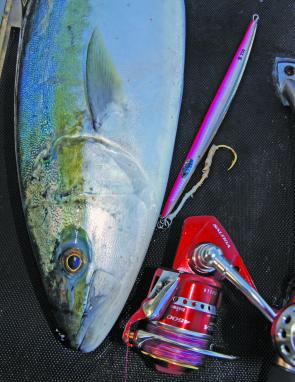
Spending up on reels for jigging may seem a bit daunting at first, but buying quality reels that are meant for the job will save a lot of hassles in the long run.

A big patch of bait showing close to 90m down. It’s a long way down there and a long way back up, so a good rod, reel and line will make things easier.
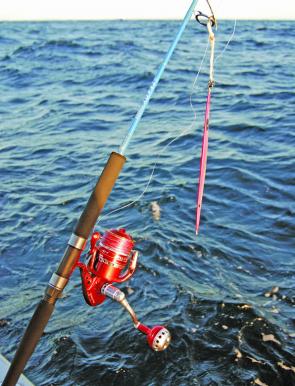
The author’s outfit rigged with a 230g Hots jig ready to be sent down to the kingfish. Every part of the system is refined and specialised, from the jig through to rod and reel. Inferior tackle tends to lead to breakdowns and lost fish.
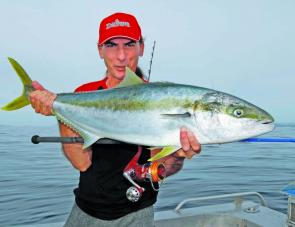
-
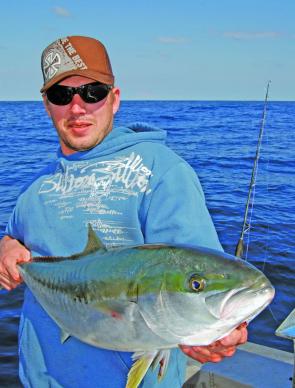
Jigging along the NSW coast is mainly about kingfish, but others that will get in on the act include bonito, samson fish, amberjacks, tuna and annoying pests like leatherjackets and barracouta.

-

-
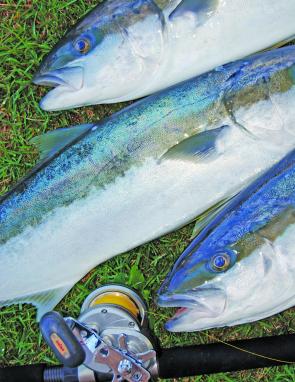
-




